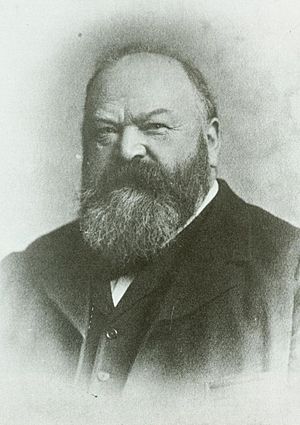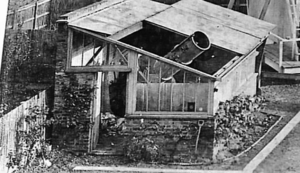Andrew Ainslie Common facts for kids
Quick facts for kids
Andrew Ainslie Common
|
|
|---|---|

Andrew Ainslie Common
|
|
| Born | 7 August 1841 |
| Died | 2 June 1903 |
| Citizenship | English |
| Known for | astrophotography |
| Scientific career | |
| Fields | Astronomy |
Andrew Ainslie Common FRS (1841–1903) was an English amateur astronomer. He is famous for his amazing work in astrophotography, which is taking pictures of space objects.
Contents
About Andrew Common
Andrew Common was born in Newcastle Upon Tyne, England, on August 7, 1841. His father, Thomas Common, was a surgeon who treated eye problems. Sadly, Andrew's father died when Andrew was young. This meant Andrew had to start working early in his life.
In the 1860s, he joined his uncle's company, Matthew Hall and Company. This company worked in sanitary engineering, which deals with public health systems. Andrew got married in 1867. He retired from his engineering job in 1890. Andrew Ainslie Common passed away on June 2, 1903, from heart failure.
His Work in Astronomy
Even though Andrew Common worked as an engineer, he is best known for his hobby: astronomy! He loved looking at the stars and planets. When he was just 10 years old, his mother borrowed a telescope for him.
He returned to astronomy in his 30s. He started taking pictures of the Moon and planets using a small 5+1⁄2 inches (14 cm) refracting telescope. He used a new method called gelatin plate photography.
In 1876, Common became a member of the Royal Astronomical Society. Around this time, he moved to Ealing, near London. He set up an observatory in his backyard. Common realized he needed very large telescopes to capture enough light for star photos. So, he started building big reflecting telescopes. These telescopes used new mirrors made of glass coated with silver.
For his first big telescope in 1876, he tried to make his own 17-inch mirror. But he decided to order an 18-inch (46 cm) mirror from George Calver instead. In 1877 and 1878, he wrote articles about what he saw through his telescope. He observed the moons of Mars and Saturn. In 1896, Common also joined the British Astronomical Association.
The 36-inch Telescope
In 1879, Andrew Common bought a new 36-inch (910 mm) mirror from Calver. He used it in an even bigger reflecting telescope he was building. With this telescope, he continued observing the moons of Mars and Saturn. He even saw Saturn's moon Mimas and found that its predicted path was wrong.
He also took a photograph of a comet in 1881, called C/1881 K1. His most famous work with this telescope was taking long-exposure photos of the Orion Nebula. He took these pictures between 1880 and 1884. His 1883 photo of the Orion Nebula was a breakthrough. It showed for the first time that photography could capture stars and features that the human eye couldn't see.
Common said about his own photos:
- "Even if some details are lost when we make the pictures bigger, enough remains to show that soon a photograph will be the best way to record the shape of a nebula and how bright its different parts are, much better than any careful drawing by hand".
These amazing pictures earned Common the Gold Medal of the Royal Astronomical Society in 1884. Common later sold his 36-inch telescope to a British politician named Edward Crossley. Crossley then gave it to Lick Observatory in 1895. It became known as the Crossley telescope there.
The 60-inch Telescope
In 1885, Common started building an even larger telescope: a 60-inch (150 cm) reflecting telescope. This time, he bought the raw glass and made the mirror himself. His first mirror didn't work well. It made stars look stretched. So, he made a second mirror in 1890.
He almost fell from the high platform needed to use the telescope. Because of this, Common decided to change the telescope's design to a Cassegrain style. This made it safer to use. To avoid drilling a hole in the main 60-inch mirror, he placed a smaller mirror in front of it. This mirror directed the image to the side of the telescope.
However, he wasn't happy with how this new setup worked. Also, he got busy with other projects. The skies west of London became more polluted with light, making stargazing harder. So, this huge telescope was not used much. After Common's death, the telescope and its two 60-inch mirrors were bought from his family. They were then set up at the Harvard College Observatory. Later, in 1933, the main mirror was improved. A new mount was built, and it was moved to Boyden Observatory in South Africa. There, it became the 1.5-meter Boyden-UFS reflector.
Other Interesting Projects
By 1890, Dr. Common was mostly retired. He spent all his time designing and building optical instruments until he died. He focused a lot on designing special telescope sights for the Royal Navy and the Royal Artillery. He was a pioneer in this field.
Captain (who later became Admiral Sir) Percy Scott, a top gunnery officer, said in 1902 that Dr. Common had designed a telescope sight. He believed this sight would "quadruple the fighting efficiency of our battleships" if used correctly. This means it would make battleships four times more effective in battle!
During the 2nd Anglo-Boer War, there were problems with rifle aiming. In response, Common designed an experimental short telescopic sight for the Lee–Enfield rifle. It could be removed and was marked for ranges up to 2000 yards. This design had features that many later military rifle scopes would use.
He also developed new ways to make large, flat optical mirrors.
Selected Honours and Awards
- Gold Medal of the Royal Astronomical Society (1884)
- Fellow of the Royal Society (1885)
- President of the Royal Astronomical Society (1895–1896)
See also



